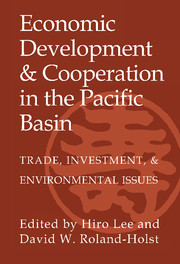 Economic Development and Cooperation in the Pacific Basin
Economic Development and Cooperation in the Pacific Basin Book contents
- Frontmatter
- Contents
- Acknowledgments
- List of Contributors
- I Introduction and Overview
- II U.S.-Japan and Asian Trade Patterns
- III Regional Trading Arrangements in the Pacific Basin
- 4 Should East Asia Go Regional?
- 5 Political Feasibility and Empirical Assessments of a Pacific Free Trade Area
- 6 Regionalism in the Pacific Basin: Strategic Interest of ASEAN in APEC
- IV Foreign Direct Investment: Determinants and Consequences
- V Trade, Resources, and the Environment
- Index
4 - Should East Asia Go Regional?
Published online by Cambridge University Press: 19 May 2010
- Frontmatter
- Contents
- Acknowledgments
- List of Contributors
- I Introduction and Overview
- II U.S.-Japan and Asian Trade Patterns
- III Regional Trading Arrangements in the Pacific Basin
- 4 Should East Asia Go Regional?
- 5 Political Feasibility and Empirical Assessments of a Pacific Free Trade Area
- 6 Regionalism in the Pacific Basin: Strategic Interest of ASEAN in APEC
- IV Foreign Direct Investment: Determinants and Consequences
- V Trade, Resources, and the Environment
- Index
Summary
INTRODUCTION
By June 1, 1995, the World Trade Organization (WTO) – the successor institution to General Agreement on Tariffs and Trade (GATT) – had been notified of more than 130 regional arrangements (Bhagwati and Panagariya, 1996b). Today, with the exception of Hong Kong and Japan, every WTO member boasts of a membership in at least one regional arrangement. Neither the successful completion of the Uruguay Round nor the recent peso crisis in Mexico has been able to reverse the rising tide of regionalism. Having already concluded Free Trade Area (FTA) agreements with its neighbors in Central and Eastern Europe, the European Union (EU) is now beginning to bring the countries in North Africa into its fold. The United States, on the other hand, has set a target date of 2005 for the creation of the Free Trade Area of the Americas (FTAA), consisting of the entire Western Hemisphere. Germany has even made overtures for a Trans-Atlantic Free Trade Area (TAFTA) between the United States and the EU.
Historically, East Asia has not been enthusiastic toward preferential trading. Until recently, the only functioning preferential trading scheme in the region was the Association of Southeast Asian Nations (ASEAN) Preferential Trading Area (APTA), which was very limited in scope. Starting in 1989, the rise of regionalism in North America and Europe led to some rethinking in the region. In 1989, the forum for Asia Pacific Economic Cooperation (APEC) was created to bring the Uruguay Round to a speedy conclusion and to promote liberalization of trade and investment policies at the regional level. APEC, which has eighteen members currently, includes countries from not only East Asia but also the Americas.
- Type
- Chapter
- Information
- Economic Development and Cooperation in the Pacific BasinTrade, Investment, and Environmental Issues, pp. 119 - 159Publisher: Cambridge University PressPrint publication year: 1998
